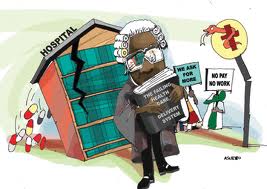By Hezekiah Shobiye
Little wonder why majority of the population still do not have access to care when they need it. One can make an educated guess as to why the country is still struggling to swim out of the deep wells of high burden of diseases and high mortality rates.
In part 1 of this series, I expounded on the private financing system of health in Nigeria and how it hinders majority of the population, especially the poor from accessing health services and treatments at the time of need. I explained that a health system where most of the health care costs are paid by individuals out of their own pockets at the moment of seeking treatment is not equitable, as it undeniably limits access to only the rich who can afford to pay, and leaves out the poorest members of the society. In this second part, I will be explaining the public financing system of health and its role in delivering care to the Nigerian populace.
As I mentioned in part 1, the public financing of health care includes allocation from government’s budget, social health insurance funds and external funding (which includes external borrowings, donations from international agencies and NGOs). The recent statistics by the World Health Organisation shows that general government expenditure on health, as a percentage of total health expenditure in Nigeria, is just 36.7%. In the face of rising health care costs and an annual population growth rate of about 2.4%, this amount of government spending is not sufficient to effectively fund any of the primary health centres, state general hospitals or the teaching hospitals in the country – the health needs of this fast growing population are not being met!
Also, government’s allocation to health care as a percentage of total government budget in 2008 was 6.4%. This seriously falls short of the 2001 Abuja declaration by the heads of state of African Union countries to allocate at least 15% of their annual budget towards the improvement of their health sectors. To worsen the case, in the proposed budget by the federal government for year 2012, government’s allocation towards health care instead of going upwards, was reduced by almost 0.4% to 6.07%. This just reflects the lack of governmental commitment to improving the health of Nigerians.
Consequently, this has resulted in the poor performance and the inability of the health system to deliver effective and efficient health care. We still do not have enough government health facilities to adequately take care of the masses – 2,000 Nigerian must fight for one hospital bed! Many of the facilities that are available are ill equipped and they often lack the resources and supplies to function effectively. There is paucity of health workers – 1 physician for every 2500 patients, who are not well remunerated or motivated to provide quality health services. This failure by the government to effectively and efficiently finance health care has inadvertently and continuously led to an increase in private hospitals and out-of-pocket payments. In addition, government hospitals and clinics now accept user fees at the point of access to care in order to finance cost of supplies and the daily running of their facilities. Little wonder why majority of the population still do not have access to care when they need it. One can make an educated guess as to why the country is still struggling to swim out of the deep wells of high burden of diseases and high mortality rates.
Previously, there was no form of programme that could financially protect the poor and allow for shared risk of health care costs among every member of the population. Recently, the National Health Insurance Scheme (NHIS) was created. The NHIS, based on a social health insurance system was established in 2005 with an overarching goal of universal health coverage by the year 2015. Exemption of user fees for pregnant women and children under five years has been possible through this scheme, but a lot still needs to be done. An in-depth analysis of the NHIS will be done in the next part of this series.

[…] continues his detailed and thorough analysis of the health system financing mechanism, with the Part 2 of the Paying for Health Series. His analysis is certainly worth reading and is incredibly timely as it presents the plight of […]
[…] continues his detailed and thorough analysis of the health system financing mechanism, with the Part 2 of the Paying for Health Series. His analysis is certainly worth reading and is incredibly timely as it presents the plight of […]
[…] Welcome to Part 3 of this series on Paying for Health in Nigeria. The focus here is on the National Health Insurance Scheme (NHIS) and its role in increasing access to needed healthcare and ensuring equitable distribution of healthcare costs. This is a continuation of the analysis on health financing systems in Nigeria started in Part 1 and Part 2. […]
[…] own health insurance scheme. Do not feel bad if you have never heard of it, just read Part 1 and Part 2 of Hezekiah Shobiye’s brilliant analyses of Nigeria’s Health Insurance Scheme. He continues […]